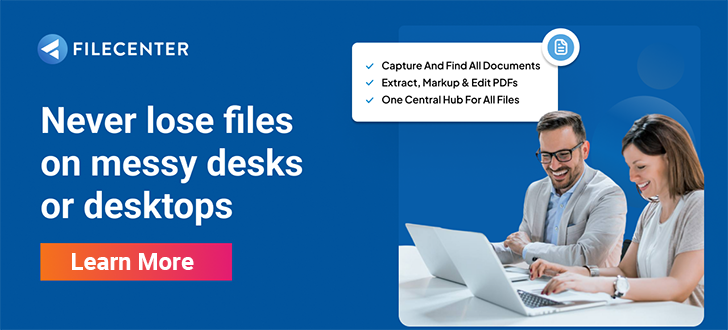Document Management vs Records Management: What Really is the Difference?
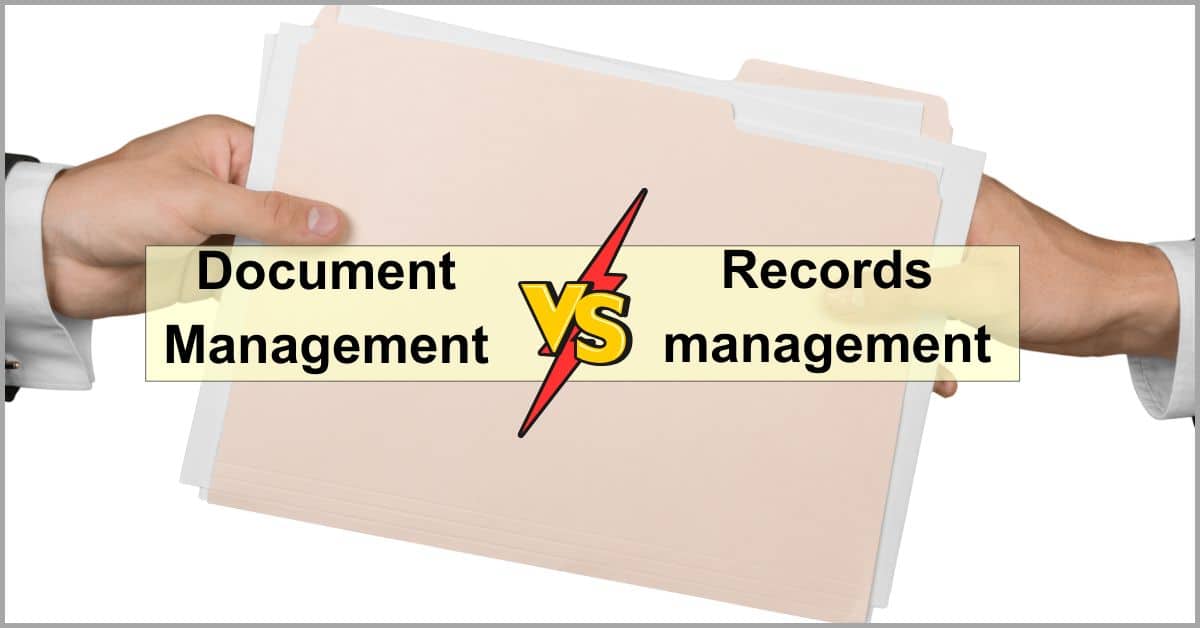
Is document and records management the same?
Records management and business document management are very different.
If you don’t properly understand the differences between them, it becomes challenging to choose the right information handling strategy for your business.
A survey by AIIM discovered that 1 in 3 businesses have below-average information management processes. This is partly because of ineffective strategies.
In order to help you find a highly effective information management technique that aligns with your small business and addresses its unique needs, I’ve compiled some important document vs records management differences for us to explore.
You’ll learn about what scenarios favor each, as well as the individual benefits and purposes of each strategy so you can decide what works best for your business.
If you’re interested in improving your accounting processes, check out this article I wrote about the best accounting document management software to use.
In this article, we’ll get into the document management vs records management debate to discuss key differences & how they can help you improve productivity & compliance.
Let’s get started.
What is document management?
Document management is an important business strategy.
It is the practice of creating, storing, organizing, retrieving and generally managing documents, and may involve the use of specialized tools such as a document management system, for example, to automate various parts of these processes.
That said, document management also involves structuring unstructured data to improve organization and make information more accessible for your business.
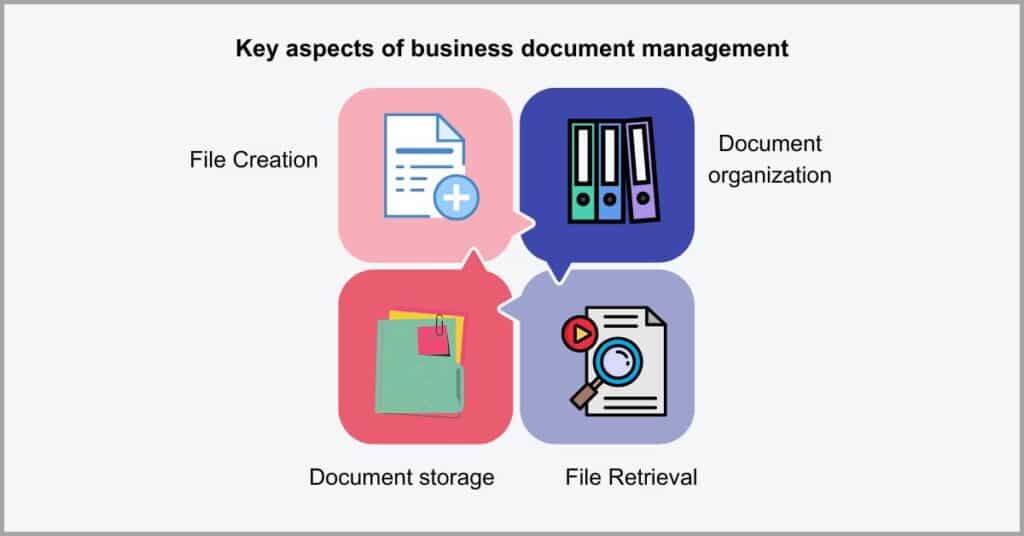
When largely-manual, however, it can be highly inefficient and resource-intensive, which is why I recommend getting a great document management software to help you out.
Transition from document chaos and begin your free FileCenter trial to streamline and automate your document workflow to improve efficiency.
With our software, you get powerful features such as OCR-driven scanning, which helps you to digitize your workflow and go paperless. It also comes with robust search capabilities, enabling you to find information faster and increase your productivity.
What is records management?
So what is a business record in the first place?
A record is essentially a document that has been finalized and approved, and may not need to be changed later on. This marks one of the most crucial document management vs records management differences to keep in mind.
By preserving documents in unchangeable formats, records management enables the long-term storage of critical information for historical references.
It may involve the use of paperless document management software to digitize final versions of documents so that you can store them electronically. In fact, oftentimes, business documents are converted into PDF/A formats for long-term storage.
Other common archival formats for records that I’ve also noticed include XML and TIFF. The latter is a particularly popular format for archiving scanned documents in the legal and medical industries.
Overall, records management involves the long-term preservation of immutable files, typically with the goal of adhering to legal, compliance and corporate policies.
Key differences between document and records management
1. Nature of documents
So what is the objective of document management?
This is a critical part of your small business workflow, and it largely deals with the creation, storage, retrieval and collaboration of active documents. So in this case, documents are dynamic meaning you can change them at any time.
With proper document management, you can expedite and standardized processes like file generation to solve efficiency issues and productivity losses.
A study by M-Files showed that you can improve workflow efficiency by 70% with great document management practices. One of those entails using a great document management system for your small business to solve various document issues.
That being said, document management largely deals with work-in-progress files that aren’t in their final form yet, and are therefore likely to change.
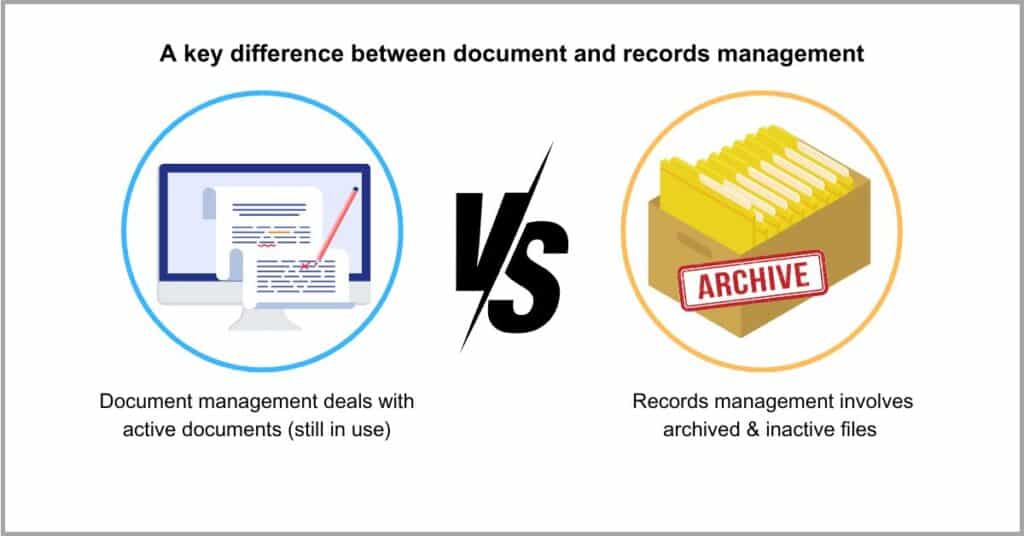
So one of the key differences between document management vs records management is the nature of files. While we’ve seen that document management entails active documents, record management deals with archived and usually immutable files.
Once a document is labelled as a record, then editing and other modification actions are typically massively restricted, with the original format also remaining unaltered in order to preserve authenticity.
If you’d like to improve both aspects of your business, a great document management software can help you manage both documents and records more efficiently.
Take charge of your document workflow and start your free FileCenter trial today to enhance your small business’s information governance strategy. With our software, you can improve document and record lifecycle management and increase productivity.
2. Goals and objectives
Certain documents require long-term preservation.
They include essential compliance-related files such as tax information, employee medical records and much more. This is where records management comes in, enabling you to archive information in unchangeable formats for compliance purposes.
So effective records management is essentially for improving compliance, and avoiding legal and financial consequences of violating regulatory requirements.
Unfortunately, at least 89% of compliance professionals said that achieving regulatory compliance has gotten harder, according to a survey by Regology. Some of the key reasons for this is the poor archival of important files and rapid regulatory changes.
This is where records management steps in to save the day, helping your small business preserve or dispose of records as per changing regulatory requirements in your industry.
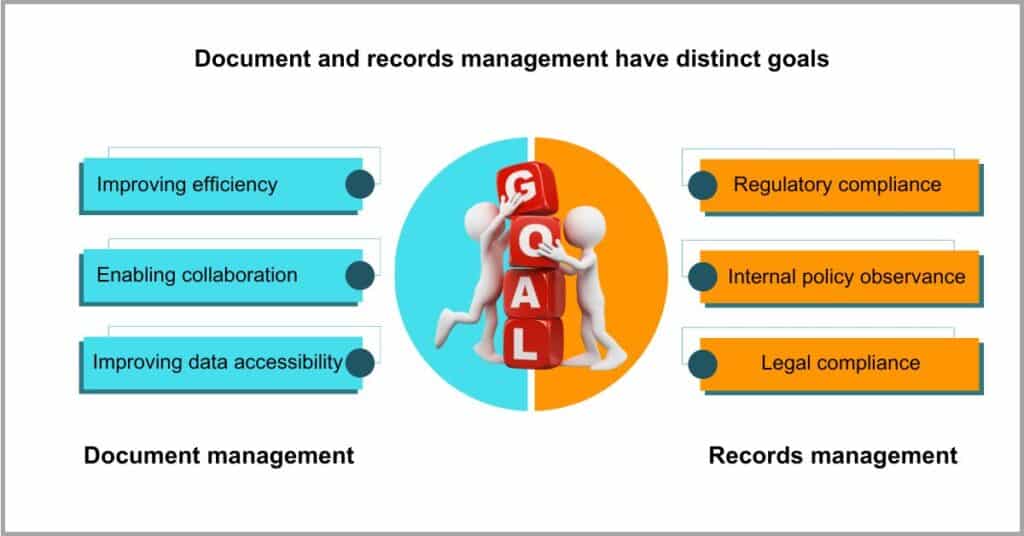
What is the purpose of document management?
While records management is largely focused on the long-term archival of information with the primary goal of improving regulatory compliance, I’ve also noticed document management has a much broader scope in terms of its objectives in comparison.
Compliance might be one of those goals, however, it’s largely concerned with enabling document collaboration, improving efficiency and making data more accessible.
Whereas in records management, the records are finalized and serve as historical evidence of important compliance-related information, document management involves the constant alteration and editing of documents to meet your business’s needs.
Overall, the goal in document management is primarily to enhance your document workflow and records management is focused on document retention and control.
3. Document lifecycles
So how do they differ in terms of document lifecycles?
When it comes to document management, you’re generally tracking and managing documents throughout their entire lifecycles. This covers what happens from the moment you create a file to the point where you eventually delete or archive it.
If you fail to effectively monitor document processes, your small business may experience cases of poor data visibility that negatively impact decision-making.
A survey by XPLM discovered that 76% of organizations face data visibility issues that hinder the cross-departmental exchange of information. They said these silos have made it very challenging for them to make accurate and timely business decisions.
It’s for this reason that I recommend putting in place practices to ensure full document lifecycle management and tracking to eliminate data silos.
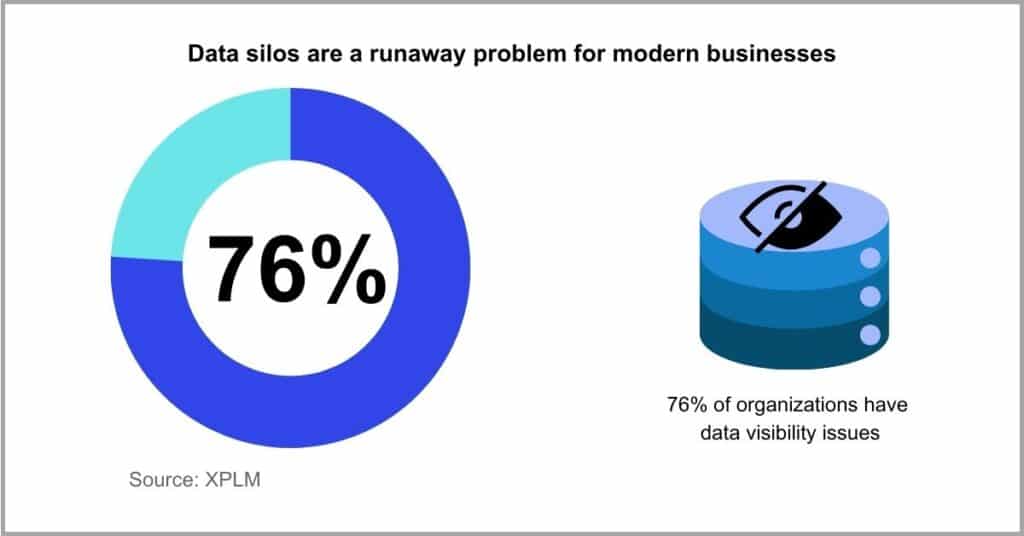
In the case of document management, you’re generally handling files right from the beginning and throughout their lifecycle, and this marks one of the most important differences between document management vs records management.
This is because corporate records management typically comes in during one stage of the document lifecycle, and that’s usually toward the end during archiving or deletion.
It’s a process which I recommend for ensuring that you dispose of unnecessary information when you no longer need it, to reduce data security risks & storage needs.
On the flip side, it also focuses on the systematic retention of records at the end of their lifecycle for the long-term preservation of important data. It may even implement robust storage measures like encryption and access control to ensure confidentiality.
4. Types of information
There are also key differences in terms of information.
When it comes to records management, we’ve pointed out that it generally deals with historical, compliance-relevant records which may not need to be altered. So it may involve documents like tax returns, processed invoices, signed contracts and more.
With records management preventing authorized modifications to original content, it’s therefore a top strategy for getting around document fraud issues.
A study by Regula brought to light that 58% of businesses experienced document fraud issues in 2024. These incidents largely involved physical documents being modified or altered by malicious third parties for their own personal gain.
This is where strategic document and records management can make a very big difference, helping to protect files from unauthorized modifications.

So what types of information does document management involve?
While you can manage all kinds of crucial small business documents, I’ve realized that document management processes typically center around documents that are in-process and active, and typically those that aren’t subject to strict regulations just yet.
Therefore, you may notice that these processes largely involve marketing content drafts, collaboration notes, unprocessed invoices and contract drafts, marking another one of the most important document management vs records management differences.
Records management, on the other hand, often focuses on human resources records, financial records, and corporate governance documents, in particular.
It may even rope in medical files and correspondence and communication records, among others, which are regulated and you may need to hold for a stipulated period.
5. Technologies involved
So what are some tools used for either process?
In this document management vs records management debate, one similarity I’ve noticed is that both leverage special automation technologies. These are largely meant at automating various processes involved in each case so as to boost efficiency.
By offering very powerful automation tools, document and records management solutions help your small business to reduce the time spent on iterative work.
A survey by Rossum recently revealed that, for 62% of businesses, document automation is a top priority for 2025. This is to be expected given the massive amounts of time you can save and the huge productivity gains on offer.
It’s important to note, however, that both document management and records management may leverage two different types of specialized technologies.
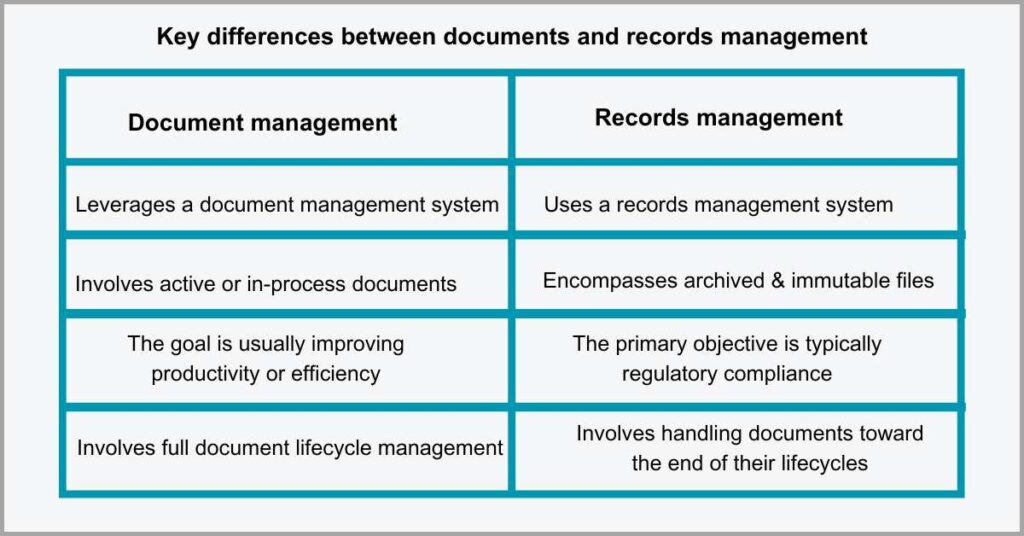
Typically, you’ll turn to document management software (DMS) for your document management needs, or a dedicated records management system (RMS) for managing essential business records more efficiently.
For your DMS, you may notice features geared toward document creation, search retrieval and collaboration, while an RMS offers automated record retention, advanced document security and other features largely for long-term document preservation.
With some tools like our software, you get a two-in-one solution.
So why not try FileCenter for free today? You can use our platform to manage all types of business documents and records more efficiently.
It comes with important document modification & editing features to cater to your document management needs. Additionally, you also get advanced document security, storage and retention capabilities to help ensure long-term, compliant-friendly archival.
How a great DMS streamlines document and records management
a) Centralized storage and organization
A great DMS can improve records & document management.
One way it does this is by allowing you to centralize information from paper records and different business systems to create a single, highly-structured repository.
When information is fractured, your small business may harbor distorted and incomplete documents while it becomes time-consuming to find files.
A survey by Airtable showed employees spend 30% of workdays just trying, and often failing, to find the right data and information. If you consider a typical 8-hour shift, this can mean a huge loss of at least 2.4 hours every single day.
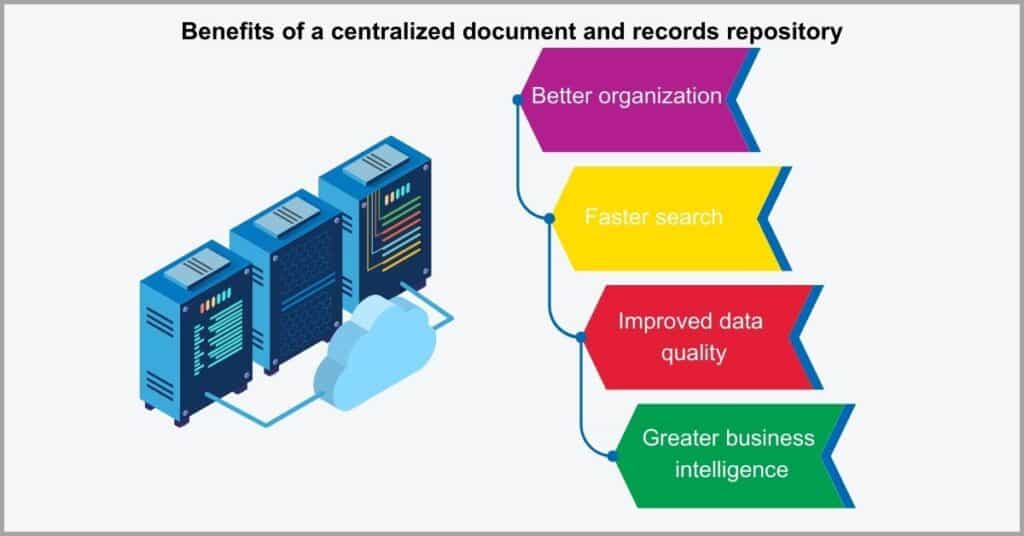
With a great tool like our software FileCenter, for example, you can even digitize paper records by pairing it with the best document scanners. This enables you to keep updated versions of files in one easy to access place so you can view them remotely.
Coupled with metadata, tags and indexing, it becomes much easier to categorize records and documents as per departmental needs, or the purpose they serve such as tax compliance, legal matters and much more.
When all your information is centralized, this reduces the risk of misplacements and also greatly improves data quality, empowering you to make data-driven decisions.
b) Automated document retention
Do you rely on a manual retention strategy?
It may get the job done, however, manually tracking and enforcing retention requirements requires a huge amount of labor and time, since it may mean having to constantly review and sort several documents and records.
In addition, your employees may also forget to follow retention schedules, while there’s the risk of miscategorization and deletions which jeopardize compliance.
A survey by Zapier found that 32% of businesses use automation technologies for various document processes, including creation, organization and retention. It’s a strategy that helps them to do more with less resources and improve accuracy.
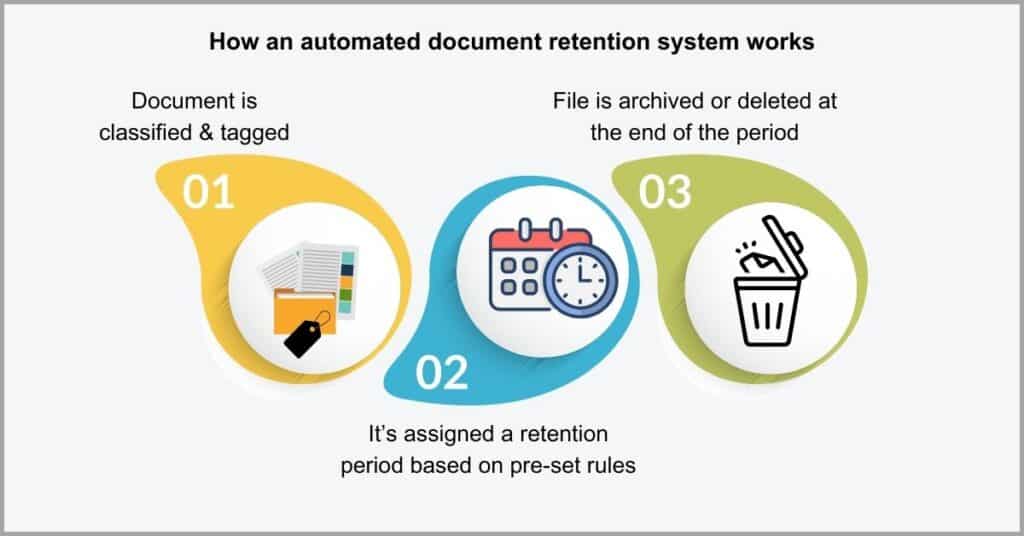
In this article about document management vs records management, creating automated retention policies is very important. This is because it reduces human involvement in the process, which greatly lowers the risk of mistakes.
In fact, with the right document management software features, such as automated retention controls, which I highly recommend enforcing, you can configure the system to discard or preserve records, according to stipulated guidelines for your small business.
This makes documents and record retention less labor-intensive as well, allowing your staff to focus on other activities other than regulatory compliance documentation.
c) Robust data security
Your small business may handle sensitive files.
This includes everything from customer forms with personally identifiable information to tax records with sensitive financial information about your small business.
If your documents and records aren’t well secured, the risk of successful data breaches, which often attract regulatory penalties and fines, greatly increases.
Unfortunately, 78% of small businesses are worried about the threat posed by data breaches, according to a survey by Connectwise. In fact, most of them believe that these could attract huge regulatory issues and, worse yet, put them out of business.
This is why I recommend using an excellent document management software to reduce cyber security risks.
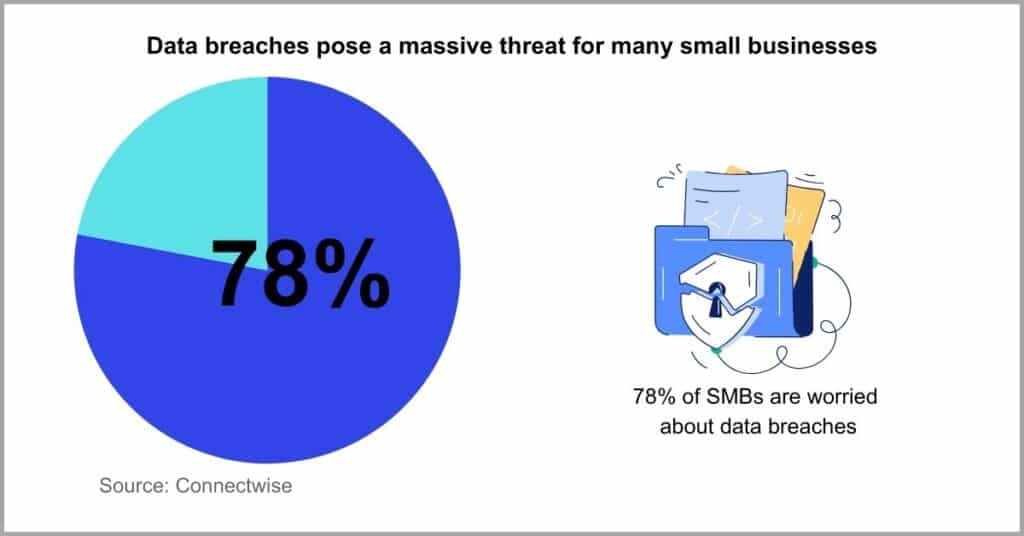
So how does a DMS improve data security?
For one, you get robust access control features, which enable you to limit access to archived records. This reduces the risk of cyber threats as well as unauthorized changes by your staff.
Some of the best cloud-based document management solutions typically also come with advanced document redaction and encryption features. These offer an additional safety layer to help keep sensitive information safe in case of a successful attack.
Last but not least, these tools also keep a detailed history of all edits and changes, creating detailed audit logs that improve document and record-keeping transparency.
Conclusion
Both processes essentially aren’t opposing forces.
They serve different but complementary purposes when it comes to information handling.
If your strategy doesn’t include effective records & document management, you may leave loopholes that invite risks and limit your small business’s success.
A survey by YouGov revealed that 50% of small businesses struggled to grow in 2023. One of the biggest factors holding them back is bad document management and records management strategies that shackle productivity and revenue.
That said, having discussed the main differences between document management vs records management, you now have the power to improve either strategy. I also recommend leveraging the right technology to drive efficiency.
If you’re keen on a holistic solution, start your free FileCenter trial. Our platform can help you manage documents and records more effectively.
Consequently, it empowers your small business to improve productivity, streamline regulatory compliance and also turbocharge revenue and overall company growth.

